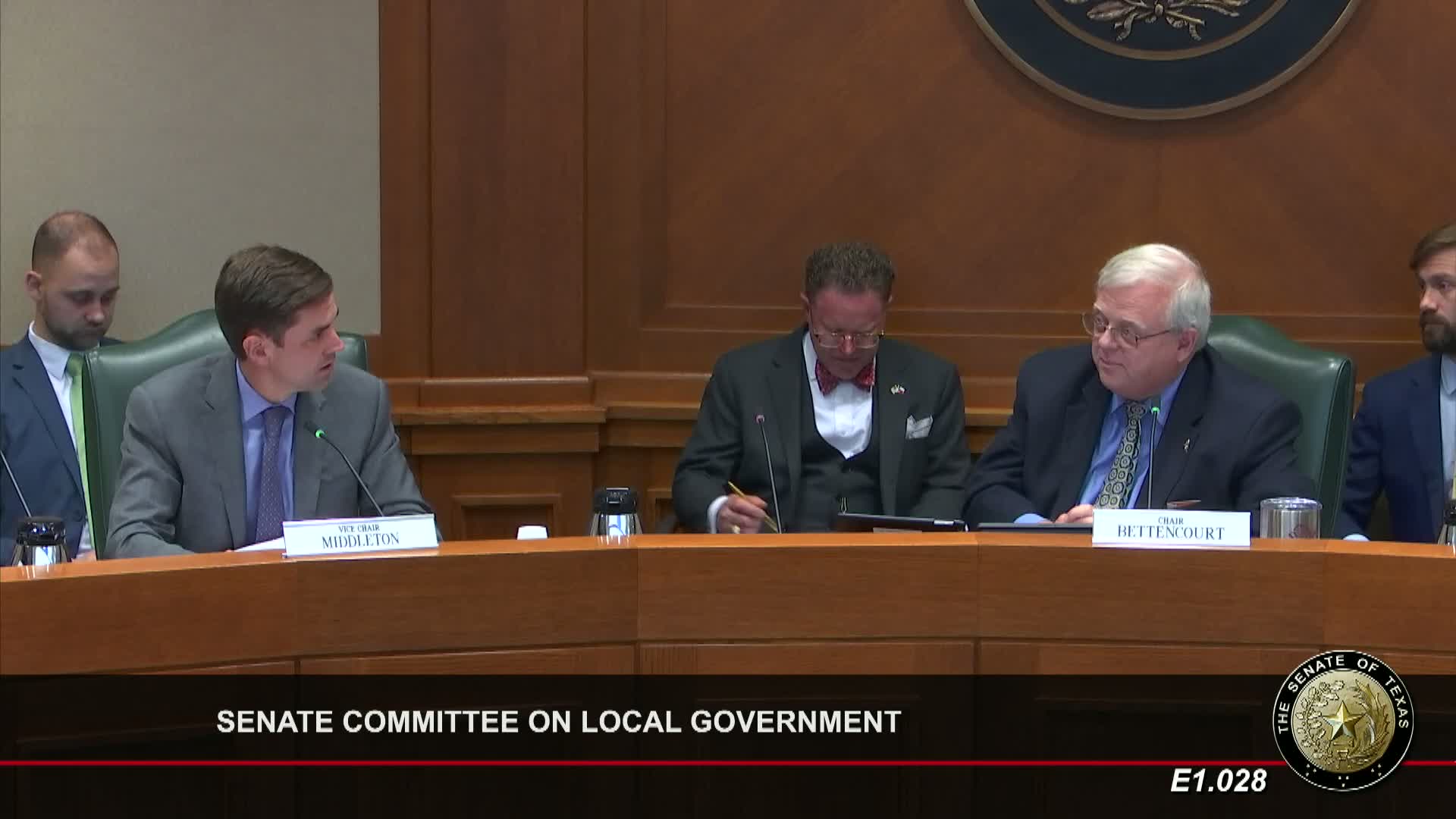Senators consider limits on noncontiguous annexations by special districts after landowner concerns
April 07, 2025 | Committee on Local Government, Senate, Legislative, Texas
This article was created by AI summarizing key points discussed. AI makes mistakes, so for full details and context, please refer to the video of the full meeting. Please report any errors so we can fix them. Report an error »

Senate Bill 19 65, filed for Senator Royce West and carried in committee by Senator Middleton on behalf of Senator John King, tackled a recurring issue in several counties: special‑purpose districts annexing noncontiguous tracts of land and acquiring taxing and condemnation authority without clear local notice.
Middleton said some special districts had added land miles away from their established boundaries, creating surprise for neighboring landowners and local officials when services or development plans were proposed. The bill would prohibit certain special districts — including municipal utility districts (MUDs), special utility districts, municipal management districts, water improvement districts and water control and improvement districts (WCIDs) — from annexing noncontiguous parcels located more than 200 feet from the district at the time of the proposed addition. The 200‑foot figure was said to match certain existing requirements used in other state regulatory settings.
The bill also would expand notice: petitioning districts must mail certified notice of hearings to each landowner in the area to be annexed and to any municipality in which the land will be located or adjacent municipalities, giving local officials and affected landowners more opportunity to participate.
Public testimony highlighted practical concerns. Jerry Holman, who represents Harris County Freshwater Supply District 61 and operates Harris County MUD 248, said many MUDs serve noncontiguous properties at landowners’ specific request and that rigid distance limits could block service to property that otherwise would not be developable without district utilities. He said the typical practice is that landowners ask to be annexed to get water and sewer service and that a strict 200‑foot rule could prevent necessary service extensions.
Trey Larry, representing land‑use and district counsel groups, urged caution about prescribing a fixed distance, arguing that every situation is unique and that an arbitrary distance could prevent necessary, cost‑effective service. He noted counties and multiple jurisdictions sometimes complicate mapping and utility service decisions.
Other members and witnesses discussed examples where noncontiguous annexations were used to serve long linear service connections or to tie into regional wastewater systems located across municipal boundaries. The committee asked the author and stakeholders to continue discussions; senators said they would seek drafting approaches that preserve the ability to extend needed utility service while closing perceived loopholes that permit seemingly opportunistic annexations.
Ending: The committee left Senate Bill 19 65 pending and asked district operators, county officials and the bill author’s staff to propose technical edits, possible exceptions for landowner‑initiated annexations or alternative distance‑based criteria.
Middleton said some special districts had added land miles away from their established boundaries, creating surprise for neighboring landowners and local officials when services or development plans were proposed. The bill would prohibit certain special districts — including municipal utility districts (MUDs), special utility districts, municipal management districts, water improvement districts and water control and improvement districts (WCIDs) — from annexing noncontiguous parcels located more than 200 feet from the district at the time of the proposed addition. The 200‑foot figure was said to match certain existing requirements used in other state regulatory settings.
The bill also would expand notice: petitioning districts must mail certified notice of hearings to each landowner in the area to be annexed and to any municipality in which the land will be located or adjacent municipalities, giving local officials and affected landowners more opportunity to participate.
Public testimony highlighted practical concerns. Jerry Holman, who represents Harris County Freshwater Supply District 61 and operates Harris County MUD 248, said many MUDs serve noncontiguous properties at landowners’ specific request and that rigid distance limits could block service to property that otherwise would not be developable without district utilities. He said the typical practice is that landowners ask to be annexed to get water and sewer service and that a strict 200‑foot rule could prevent necessary service extensions.
Trey Larry, representing land‑use and district counsel groups, urged caution about prescribing a fixed distance, arguing that every situation is unique and that an arbitrary distance could prevent necessary, cost‑effective service. He noted counties and multiple jurisdictions sometimes complicate mapping and utility service decisions.
Other members and witnesses discussed examples where noncontiguous annexations were used to serve long linear service connections or to tie into regional wastewater systems located across municipal boundaries. The committee asked the author and stakeholders to continue discussions; senators said they would seek drafting approaches that preserve the ability to extend needed utility service while closing perceived loopholes that permit seemingly opportunistic annexations.
Ending: The committee left Senate Bill 19 65 pending and asked district operators, county officials and the bill author’s staff to propose technical edits, possible exceptions for landowner‑initiated annexations or alternative distance‑based criteria.
View full meeting
This article is based on a recent meeting—watch the full video and explore the complete transcript for deeper insights into the discussion.
View full meeting
